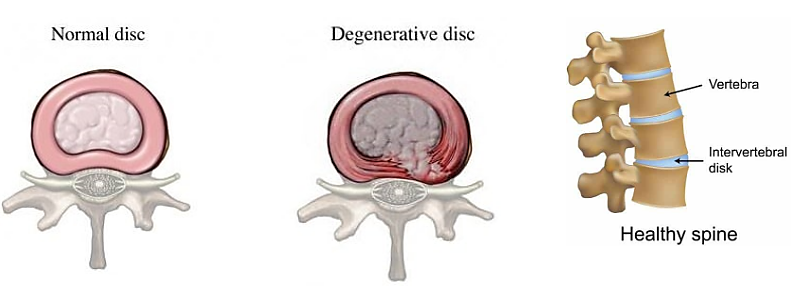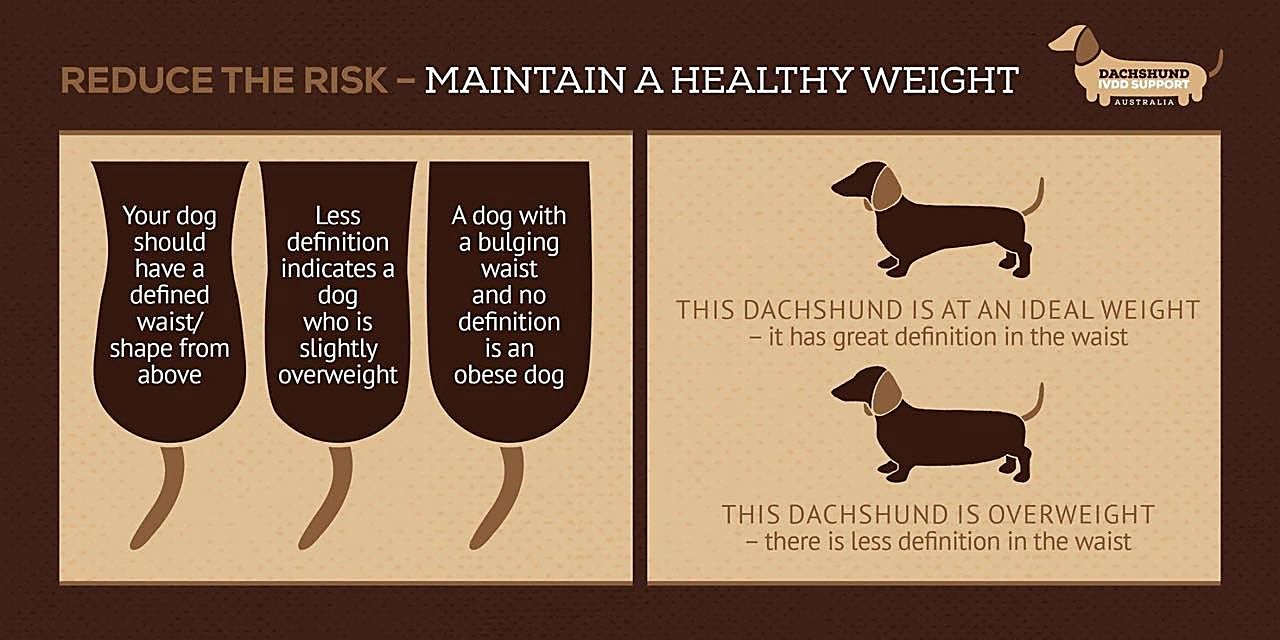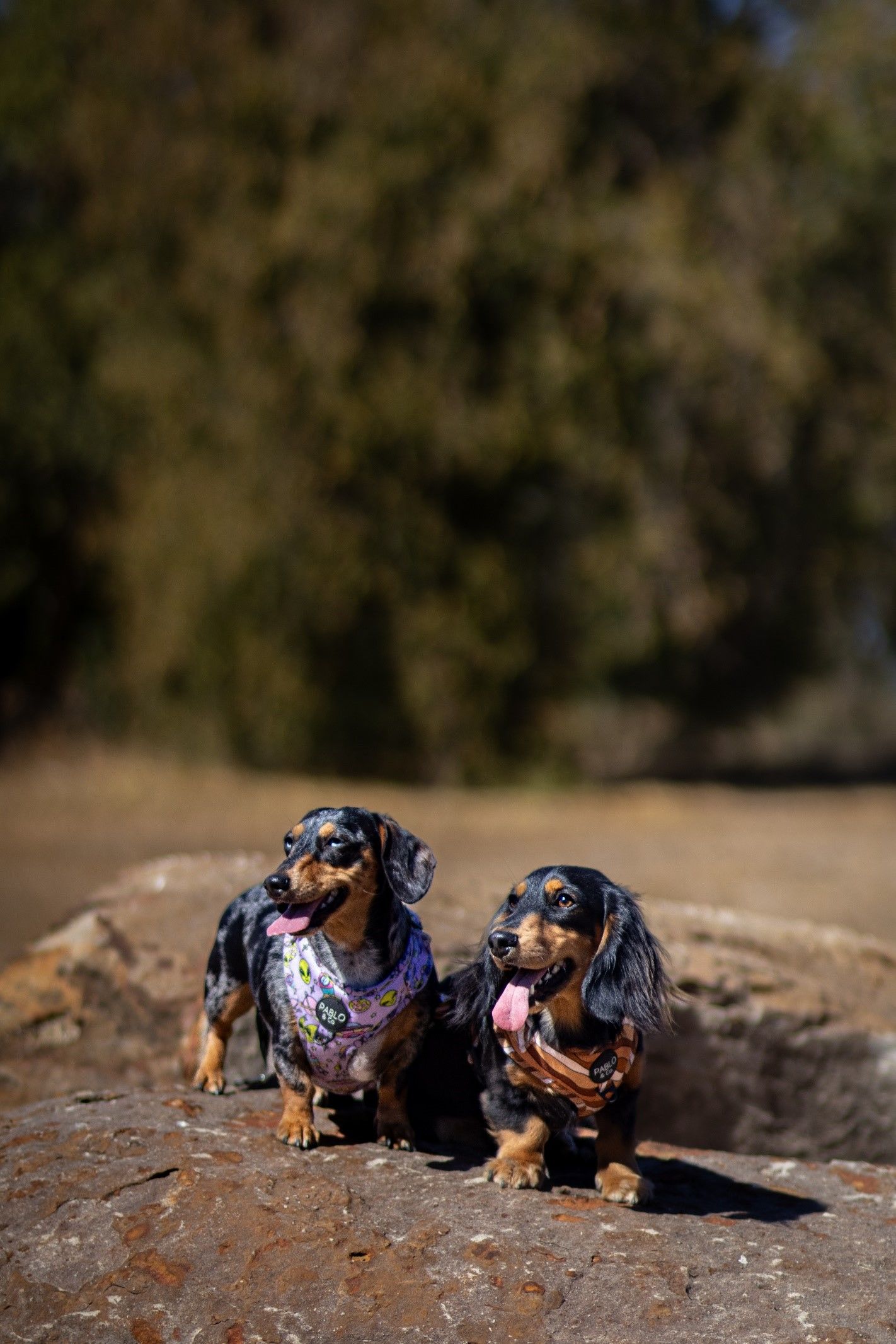It’s no surprise we see so many Dachshunds in Central Queensland, they capture the hearts of so many pet owners with their confident personality and unique shape. Unfortunately because of their elongated bodies, short legs and stamina, they are more susceptible to intervertebral disc disease (IVDD).
It’s important for dachshund owners to be aware of IVDD which requires caution with physical activities to avoid injury as well as good weight management.
What is IVDD?
Intervertebral disc disease, commonly referred to as IVDD, is a condition that affects 25% of dachshunds (can affect other breeds as well). Intervertebral discs are circular pads of cushioning situated between each vertebra of the spine. What happens over time is these discs start to deteriorate (calcify/harden), which then become susceptible to bulging or bursting, especially with certain physical activity such as jumping off the couch or rough play. These discs are important for the normal function of the spine, they also protect the vertebrae and nerves down middle of spine.

Causes of IVDD
IVDD has a strong genetic (short-legs) and heritable (runs in families) aspect. Dachshunds are a short-legged breed remains the biggest causal factor in IVDD because the discs in the spine calcify at a much younger age than in normal-legged breeds of dogs.
Unfortunately, just because your dog is fit and in good body condition does not guarantee that it will avoid back problems. It is likely to be a disease caused by multiple genes as well as environmental and lifestyle factors.
Signs & Symptoms
| Symptoms that may be observed include: | As damage to the spinal cord increases, your dog’s symptoms may worsen: |
|
|
Reduce the Risk!
Here are some tips on ways to prevent IVDD in your sausage dog:
Weight Management
It’s important for dachshunds to have a complete, well-balanced diet to ensure they are kept in the best body condition and provided with important nutrients. Each dog is different depending on life stage (puppy vs adult vs senior) and lifestyle (highly active vs not very active).
Obesity is one of the most common health issues for pets and identified as an increased risk factor of IVDD. Therefore it’s important to monitor your pet’s body condition, take a moment and run your hands over your Dachshund … can you easily feel the ribs, spine and pelvic bones underneath its coat and soft tissue?
Check out the below Weight Chart and if your snag is looking a little on the “chonky” side, it might be time to look at diet and slow down on the extra snacks or cut back the quantity.
Measuring cups and digital kitchen scales are a great way to monitor food intake!

Supplements are also available to assist our dogs with their health including joint supporting properties such as 4Cyte, Antinol, Omega 3 Oils and prescription diets such as Hills Mobility.
Exercise
Ideally, every Dachshund should avoid high-impact activities, especially jumping, high-speed running, and any activity that will put excessive force on the spine.
Some of the common activities that many Dachshunds take part in every day and ideally should avoid include:
- Jumping up/off the bed or couch or car
- Going up/down stairs
- Running at high speed to chase something i.e. dog, car, ball
- Rough-housing with other pets or humans
See below some tips on how to avoid putting unnecessary stress on your Dachshund’s backs and safely exercise them to help avoid injury:
- Walking: Walking your Dachshund is a great way to keep them fit and healthy, however it’s important to teach them walking on a lead without pulling ahead of you. The pulling and jerking is what puts added strain on their whole spine. If you’re still training your dachshund to walk politely on a lead, it’s recommended to use a harness and lead to help control walks.
- Crating: Consider crating at night and confining to a pen during the day when not at home to prevent high-risk activities. Crates make for great doggy dens and provide a safe and comfortable sleeping environment. Crate training your dachshund will ensure they are used to a crate in the event of any future circumstances that would require a prolonged confinement and rest.
- No Soft Sand: Limit your Dachshund to only walking on firm sand and carry them across the soft sand. As much as dogs love the beach, the soft sand can cause strain on the knees and long backs.
- Life Jackets: If your Dachshund loves water and you take them swimming, it is highly recommended to invest in a doggy life jacket, one that is suitable for this breed (ensure the jacket covers their backs). Snags have short lets and long backs so they need to work much harder to stay afloat. The lifejacket helps your dog to not have to work as hard and will assist they don’t end up with back strain.
- Ramps: Ramps have a modest incline and highly recommended to implement throughout the home! These can be bought or constructed and strategically placed. Dogs can be trained to use the ramp instead of jumping up and down off furniture or using some stairs to prevent back injury.
- Safe Lifting: Always ensure anyone lifting a Dachshund knows how to safely support their back. Always pick up and carry correctly to avoid back injury. Always use one hand to support the chest and the other hand to support the rump. Always keep their body level to avoid excessive twisting of the back.
Vet Checks
Regular check-ups with a veterinarian and a proactive approach to health care can help ensure a Dachshund leads a long, healthy life.
Pet Insurance
Pet insurance and finance plays a crucial role in managing the care of Dachshunds, especially if your dog is hospitalised or rushed to the nearest speciality clinic for urgent surgery. Current statistics reveal that 1 in 4 Dachshunds will go through some form of disc episode in their lifetime, and considering the expenses linked with spinal surgery and alternative therapies can be extremely costly, it’s essential to plan ahead and consider these options when facing the challenges of IVDD.
Some key points to consider:
- Having pet insurance can help cover the costs of unexpected vet bills, including those associated with IVDD treatment. It’s important to choose a policy that covers chronic conditions like IVDD, as some may have limitations or exclusions.
- Savings and Emergency Funds: Setting aside savings or creating an emergency fund specifically for your Dachshund’s healthcare needs can provide a financial safety net in case of unexpected expenses.
Dachshund IVDD Support Australia (DISA) has so much helpful information on IVDD! Their mission is to support the Dachshund community by increasing awareness, providing educational resources, and offering support for Intervertebral Disc Disease (IVDD).
DISA also has some useful information on what to consider when choosing an insurance provider for Dachshunds that we recommend you have a read of - https://ivdd.org.au/awareness/pet-insurance/
